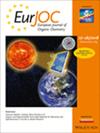9,9-双(4-二苯基氨基苯基)芴修饰的双极性非掺杂近红外高效电致发光器件
IF 2.5
3区 化学
Q2 CHEMISTRY, ORGANIC
引用次数: 0
摘要
在此,我们报告了基于不对称供体-受体-供体‘ (D-A-D’)结构的高效双极性电荷载流子的合成和表征,即MNTFT, PNTFT和BMNTFT,以及它们作为非掺杂发射器在近红外有机发光二极管(oled)中的应用。这些分子包括萘[2,3-c][1,2,5]噻二唑(Nz)为强a,二(4-二苯基氨基苯基)芴为D,二苯胺或二甲基氨基苯基为D'。实验和理论研究都证实,它们表现出杂交的局部和电荷转移(HLCT)激发态,这使得通过具有强近红外发射(~ 708 nm)的高空反向系统间交叉(hRISC)获得三重态热激子的途径成为可能。其不对称的D-A-D特性有利于良好平衡的空穴和电子迁移率,从而成功地应用于具有良好性能的oled中的非掺杂发射层。特别是,基于mft的非掺杂器件显示出峰值在710 nm的近红外发射,最高外量子效率(EQEmax)高达2.51%,导通电压低至3.2 V。这些结果代表了近红外荧光材料和OLED器件发展的重大进步,满足了各种应用的关键要求。本文章由计算机程序翻译,如有差异,请以英文原文为准。
9,9-Bis(4-diphenylaminophenyl)fluorene Modified Naphthothiadiazoles as Ambipolar Non-doped Near-Infrared Emitters for High-Efficiency Electroluminescent Devices
Herein, we report the synthesis and characterization of efficient ambipolar charge-carrier transporting deep-red to near-infrared (NIR) fluorophores, namely MNTFT, PNTFT, and BMNTFT, based on an asymmetric donor-acceptor-donor' (D-A-D') structure, as well as their application as non-doped emitters in NIR organic light-emitting diodes (OLEDs). The molecules comprise naphtho[2,3-c][1,2,5]thiadiazole (Nz) as a strong A, bis(4-diphenylaminophenyl)fluorene as D, and either diphenylamine or dimethylaminophenyl as D'. Both experimental and theoretical investigations confirm that they exhibit hybridized local and charge-transfer (HLCT) excited states, which enable the pathways for harvesting triplet hot exciton via high-lying reverse intersystem crossing (hRISC) with intense NIR emissions (∼708 nm). Their asymmetrical D-A-D' features benefit well-balanced hole and electron mobilities, resulting in a successful application as a non-doped emissive layer in the OLEDs with decent performance. Particularly, the MNTFT-based non-doped device shows an NIR emission with a peak at 710 nm, a high maximum external quantum efficiency (EQEmax) of 2.51%, and a low turn-on voltage of 3.2 V. These results represent a significant advancement in the development of NIR fluorescent materials and OLED devices, meeting key requirements for various applications.
求助全文
通过发布文献求助,成功后即可免费获取论文全文。
去求助
来源期刊
CiteScore
5.40
自引率
3.60%
发文量
752
审稿时长
1 months
期刊介绍:
The European Journal of Organic Chemistry (2019 ISI Impact Factor 2.889) publishes Full Papers, Communications, and Minireviews from the entire spectrum of synthetic organic, bioorganic and physical-organic chemistry. It is published on behalf of Chemistry Europe, an association of 16 European chemical societies.
The following journals have been merged to form two leading journals, the European Journal of Organic Chemistry and the European Journal of Inorganic Chemistry:
Liebigs Annalen
Bulletin des Sociétés Chimiques Belges
Bulletin de la Société Chimique de France
Gazzetta Chimica Italiana
Recueil des Travaux Chimiques des Pays-Bas
Anales de Química
Chimika Chronika
Revista Portuguesa de Química
ACH—Models in Chemistry
Polish Journal of Chemistry.

 求助内容:
求助内容: 应助结果提醒方式:
应助结果提醒方式:


